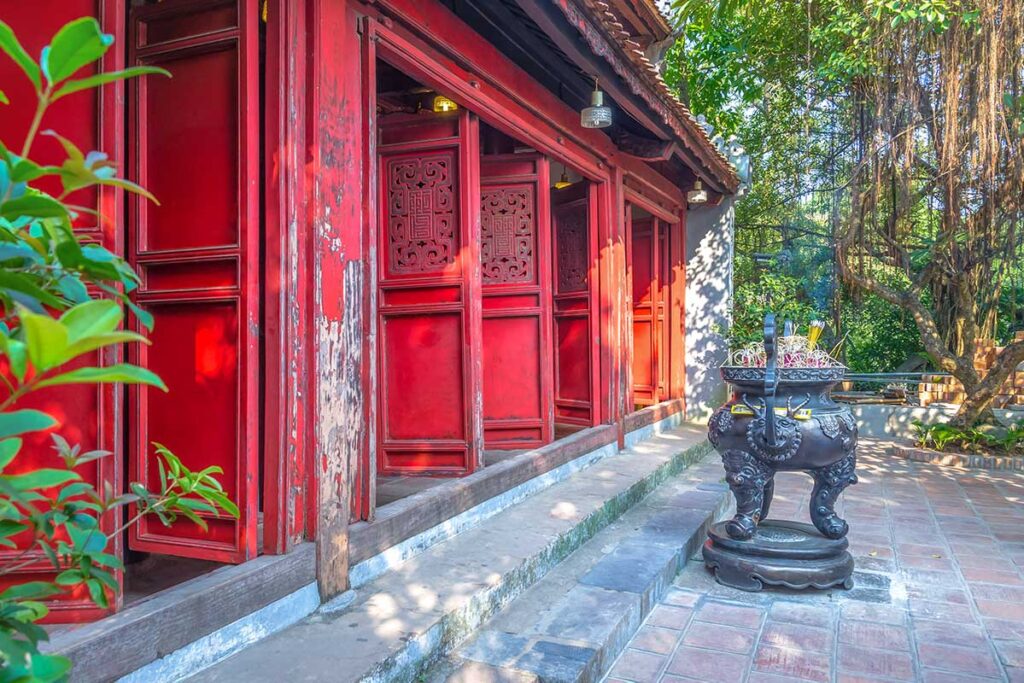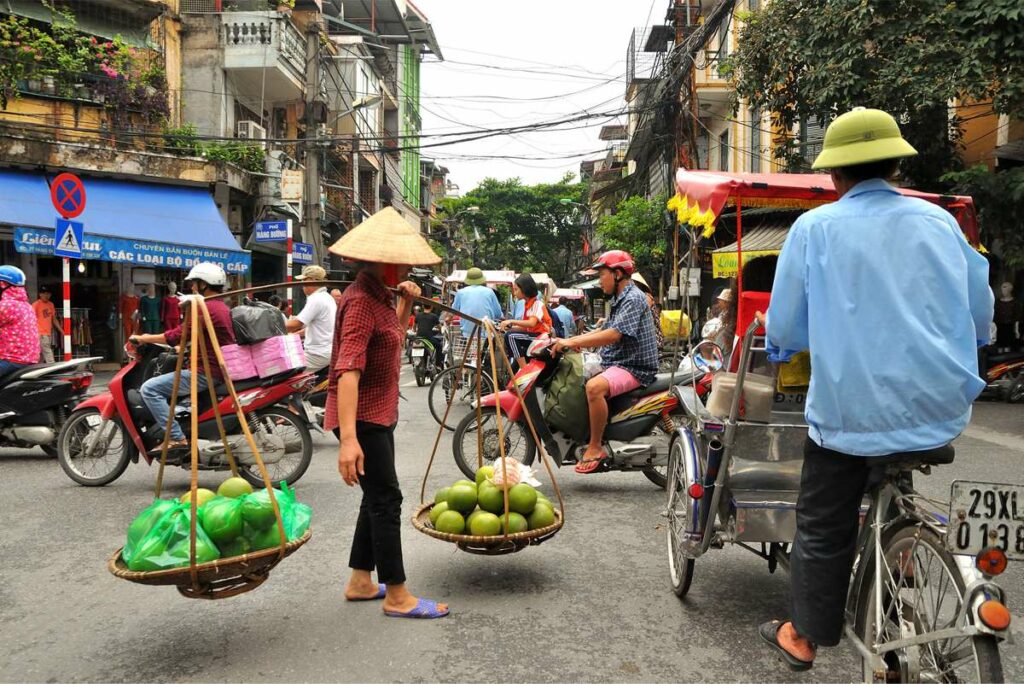What is Ngoc Son Temple?
Ngoc Son Temple, also known as the Temple of the Jade Mountain, sits on a small island in Hoan Kiem Lake in central Hanoi. Reached by the bright red The Huc Bridge, it’s one of the most recognizable landmarks in the city. The temple complex blends history, religion, and legend: it honors national heroes, Taoist and Buddhist deities, and is closely tied to the famous story of the returned sword and the giant turtle of the lake.
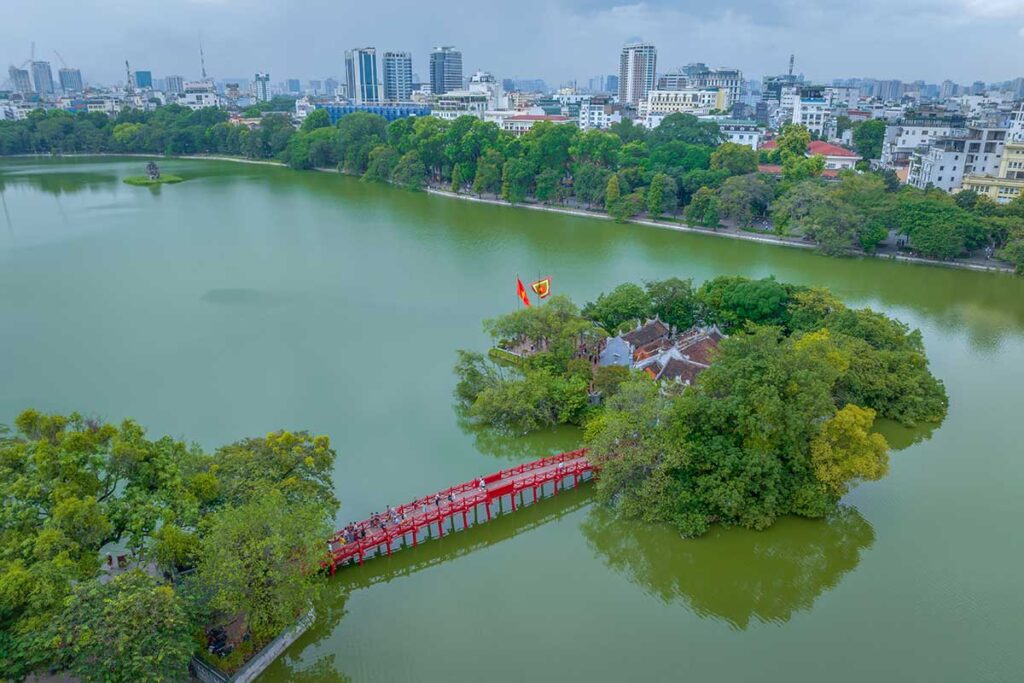
Although it attracts plenty of tourists, the temple is still an active place of worship for locals who come to pray for luck, health, or success in exams. Because of its location in the Old Quarter, it’s very easy to include in a city walk, whether you plan to go inside or simply admire the bridge and island from the lakeside.
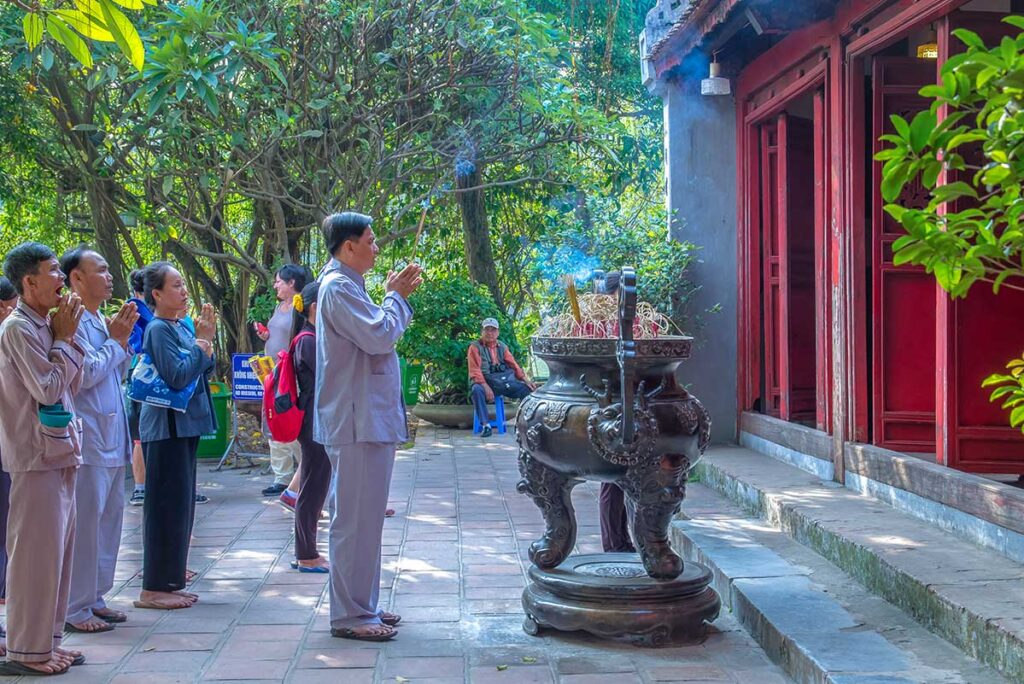
Legends and History of Ngoc Son Temple
The legend of the Lake and the Turtle
Ngoc Son Temple is closely connected to the famous legend of Hoan Kiem Lake. According to the story, Emperor Le Loi was given a magical sword by the gods to help him lead Vietnam to victory against Ming invaders in the 15th century. After the war, while boating on the lake, a giant turtle rose from the water and took the sword back to the depths, returning it to the gods. From then on, the lake became known as Hoan Kiem, or “Lake of the Returned Sword.”
Turtles are considered symbols of wisdom, longevity, and protection in Vietnamese culture, and their presence here strengthens the temple’s spiritual meaning. Inside Ngoc Son Temple, preserved specimens of giant soft-shell turtles remind visitors of the deep link between the temple, the lake, and this enduring national legend.
Founding and Development
The temple itself is more recent than the legend. It was first built in the 19th century, dedicated to a mix of figures that reflect Vietnam’s history and spiritual traditions. Among them are General Tran Hung Dao, the national hero who defeated Mongol invasions in the 13th century, and Van Xuong De Quan, a Taoist deity linked to literature and learning.
In 1865, the scholar Nguyen Van Sieu oversaw a major restoration of the site. He added some of the most recognizable features still standing today, including The Huc Bridge, the Pen Tower, and the Ink Slab. His work turned the small island into a larger architectural and cultural complex, blending symbolism, aesthetics, and worship.
Ngoc Son Temple today
In 2013, Ngoc Son Temple was recognized as a National Special Relic, cementing its importance as part of Hanoi’s heritage. Today it serves a dual role: part spiritual site for locals who come to light incense and pray, and part tourist attraction for those exploring Hoan Kiem Lake and the Old Quarter.
It’s not a large or elaborate temple compared to others in Vietnam, but its central location, layered history, and the symbolism of the lake make it a meaningful stop for anyone interested in understanding Hanoi’s cultural heart.
Highlights of visiting Ngoc Son Temple
1. Nghi Mon Gate
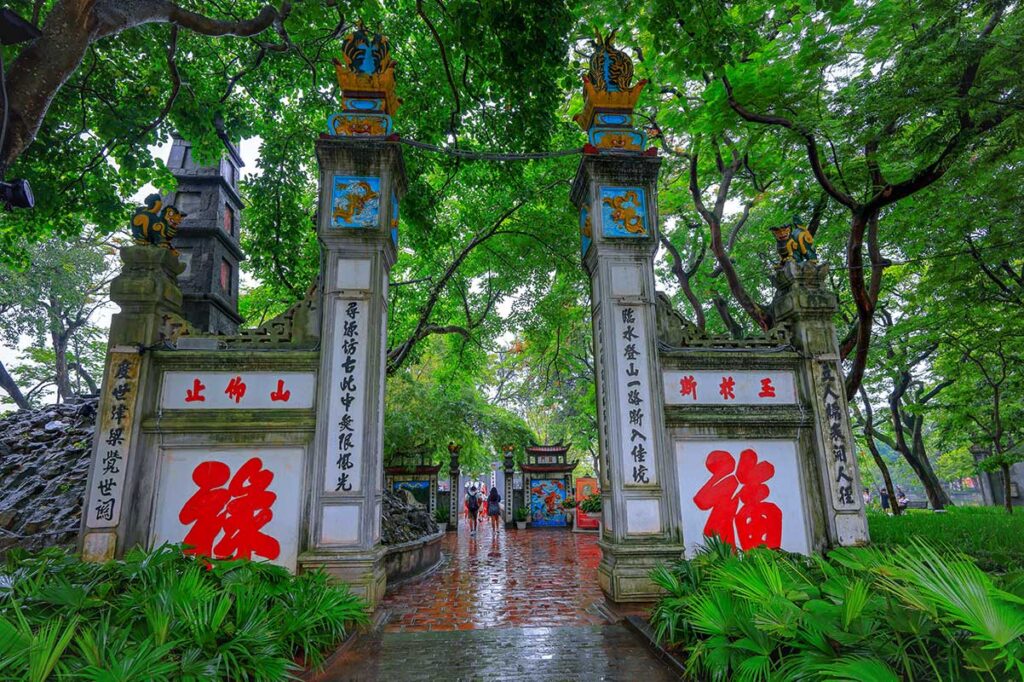
The entrance to the complex is marked by Nghi Mon Gate, a traditional-style gate with tall columns engraved with Chinese characters. It sets the tone for the visit, signaling that you’re stepping into a place of worship and history.
2. Pen Tower (Tháp Bút)
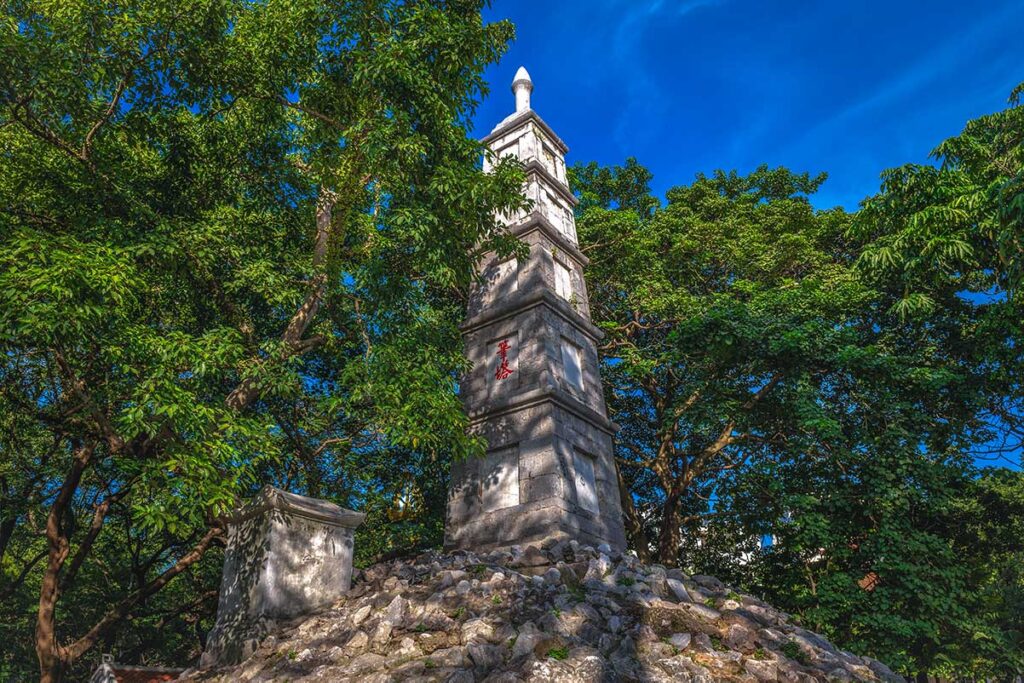
To the left of the entrance stands the Pen Tower, built in 1865 on a small rocky mound. Shaped like a giant pen pointing to the sky, it symbolizes the importance of literature and education in Vietnamese culture. The phrase “Tả Thanh Thiên,” meaning “write onto the sky,” is carved here, reinforcing the idea that knowledge and virtue are eternal.
3. Ink Slab (Đài Nghiên)
Near the base of the Pen Tower is the Ink Slab, carved from blue stone and supported by three stone toads. An inscription of 64 Chinese characters written by scholar Nguyen Van Sieu is etched into the surface. At sunrise on the 5th day of the 5th lunar month, the tower’s shadow aligns with the ink slab—a small but symbolic design detail.
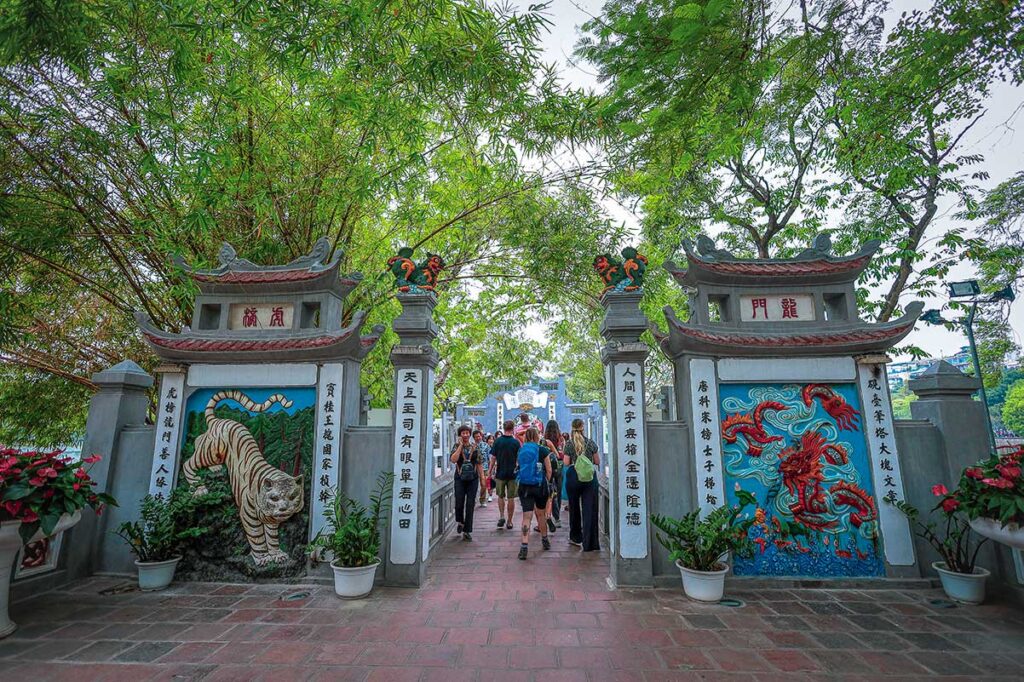
On the approach, you’ll also pass through the Dragon–Tiger Gate (Long Môn Hổ Bảng). One wall is decorated with a tiger and the other with a dragon, both symbols of strength and wisdom. Together they represent the challenges scholars must overcome, linking naturally to the temple’s literary and educational symbolism.
4. The Huc Bridge
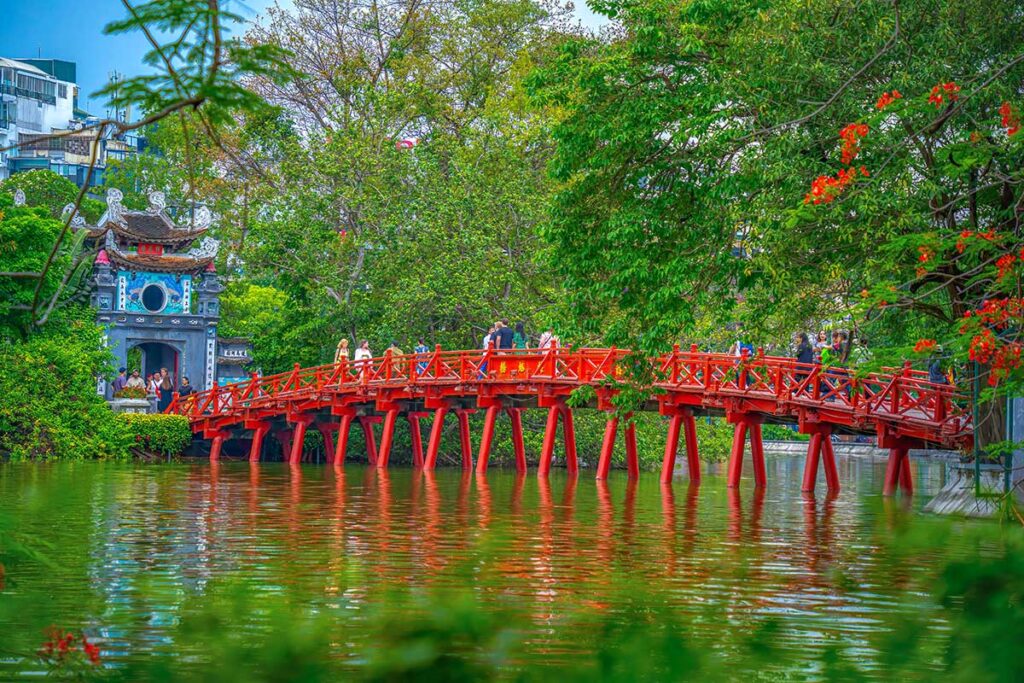
The most famous feature of the temple is The Huc Bridge, the bright red wooden walkway curving over the lake. Its name means “place of morning sunlight,” and it’s particularly atmospheric in the early hours or when it glows under lights at night. Many visitors find the walk across the bridge to be just as memorable as the temple itself.
5. Moon Gazing Pavilion
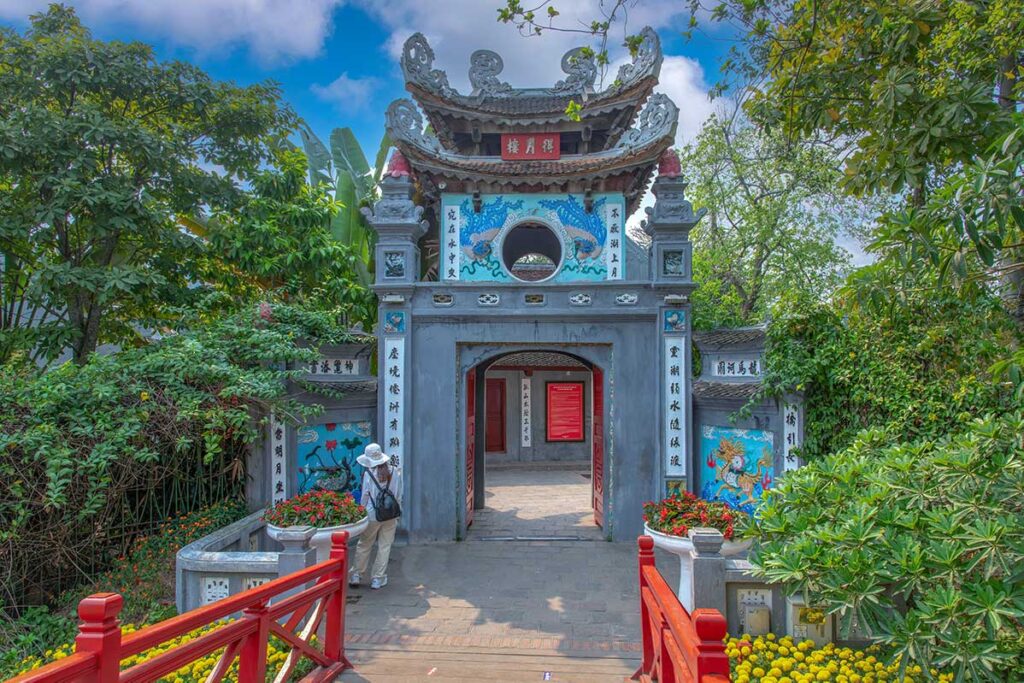
At the end of The Huc Bridge stands the Moon Gazing Pavilion (Đắc Nguyệt Lâu), a two-story gate shaded by an old banyan tree. Dragons, phoenixes, and round windows decorate the structure, giving a sense of balance and harmony. It’s a pleasant spot to pause before stepping further into the temple grounds.
6. Tran Ba Pavilion
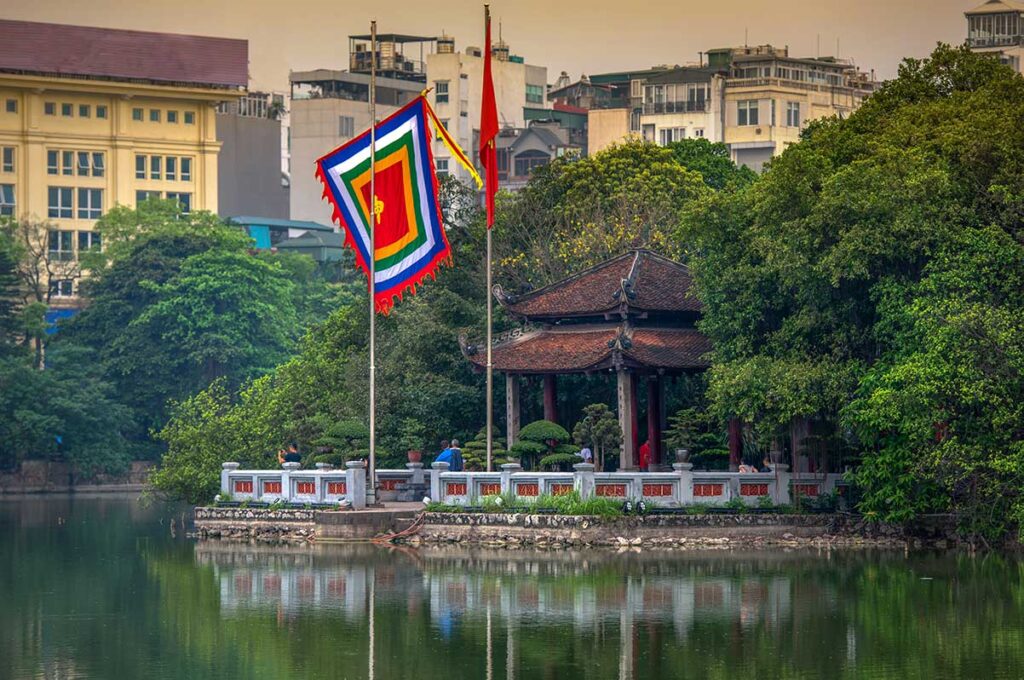
This square pavilion with eight supporting columns was designed as a symbolic “wave breaker,” protecting Vietnamese culture from foreign influence during the feudal era. It’s not a large structure, but it carries meaning for locals and adds to the variety of the complex.
7. Main Temple Area
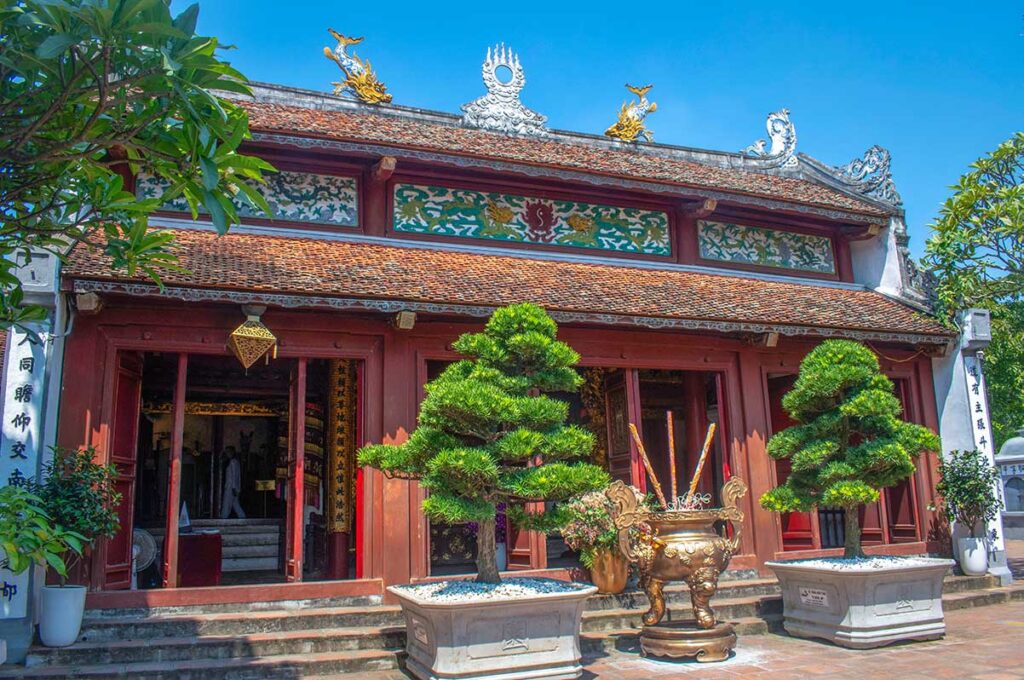
The heart of the island is the temple itself, with two connected halls. One hall contains statues of General Tran Hung Dao and Van Xuong De Quan, while another displays a statue of Amitabha Buddha—showing the blend of Taoist, Confucian, and Buddhist influences in Vietnam. Incense burns here daily, as visitors and locals stop to pray.
8. The Legendary Turtles
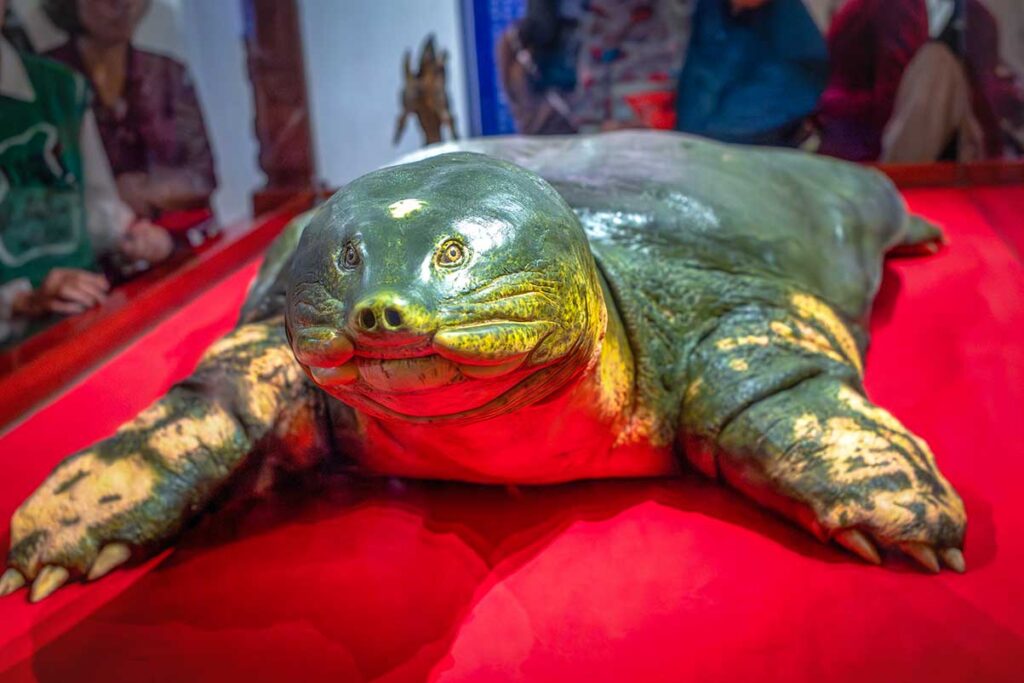
Inside the temple you’ll also find preserved specimens of giant soft-shell turtles that once lived in Hoan Kiem Lake. These animals are deeply tied to the legend of Emperor Le Loi and the returned sword. While a little unusual for first-time visitors, they highlight how myth and real life overlap at this site.
9. Views of Hoan Kiem Lake
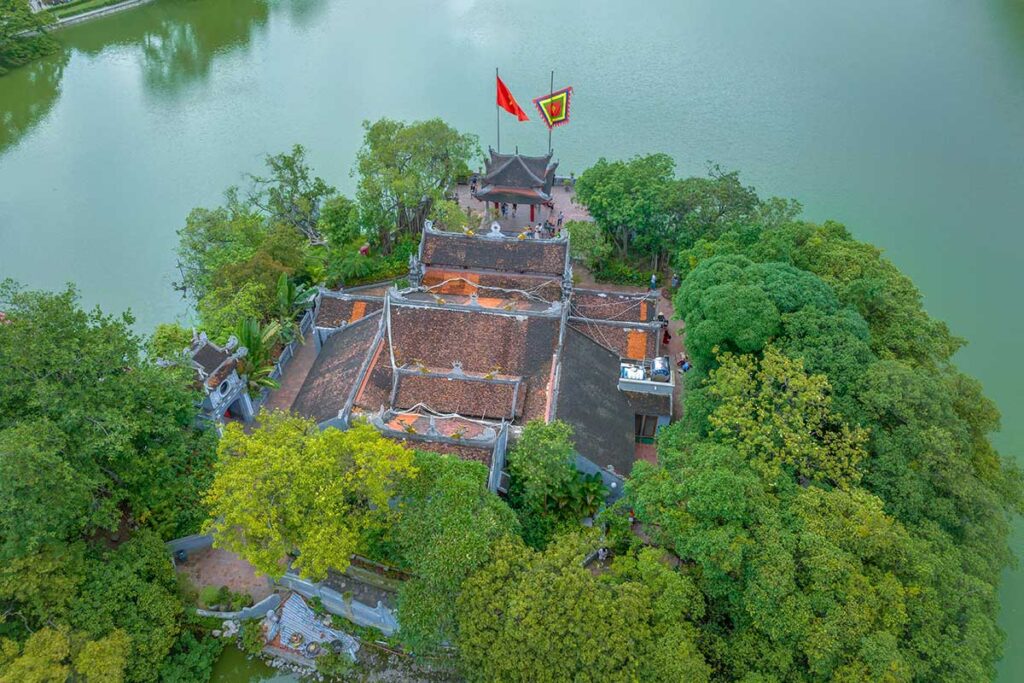
Beyond the temple buildings, one of the best parts of visiting Ngoc Son Temple is the perspective it gives over Hoan Kiem Lake. From the island you can look back at the Old Quarter, enjoy a quieter angle of the busy city, and take photos of the iconic red bridge from a different viewpoint. Even if the temple itself is modest, these views make the stop worthwhile.
Practical visiting information
Location
Ngoc Son Temple is located on Jade Island, connected to the shore of Hoan Kiem Lake by The Huc Bridge. The entrance is on the northeastern side of the lake, directly across from the Thang Long Water Puppet Theater and just steps from the Old Quarter.
Getting There
The temple is in one of the most central and walkable parts of Hanoi, so most visitors reach it on foot while exploring the Old Quarter. Taxis and ride-hailing apps like Grab can drop you off right at the entrance. If you prefer public transport, several buses stop near Hoan Kiem Lake, including routes 08, 14, 31, and 36. Renting a motorbike is possible, but parking in this area can be tricky and streets are often congested.
Opening Hours
- Weekdays: 7:00 am – 6:00 pm
- Weekends: 7:00 am – 9:00 pm
Even if you visit outside these hours, the bridge and island remain beautifully lit up at night and can be enjoyed from the lakeside.
Entrance Fee
- Adults: 50,000 VND
- Children under 15: Free
Tickets are sold at the small booth by the entrance before crossing The Huc Bridge. Cash only, so bring small bills.
Dress Code & Etiquette
Ngoc Son Temple is both a tourist attraction and an active place of worship. While the rules are not as strict as at larger religious sites, it’s respectful to:
- Wear modest clothing (cover shoulders and knees; avoid shorts and crop tops).
- Remove hats when entering the shrine.
- Take off shoes before stepping inside the main temple hall.
- Keep voices low and avoid laughing or talking loudly.
- Photography is allowed outside, but taking photos inside the altar room is often discouraged.
Following these guidelines will make your visit smoother and show respect to both the site and local worshippers.
Best time to visit Ngoc Son Temple
Avoiding crowds
Because of its location in the heart of Hanoi, Ngoc Son Temple can feel crowded at almost any time of day. If you’d like a calmer visit, aim for the early morning just after opening, when the air is cooler and there are fewer tour groups. Weekdays are generally quieter than weekends, when more local families and domestic tourists come.
Evening views
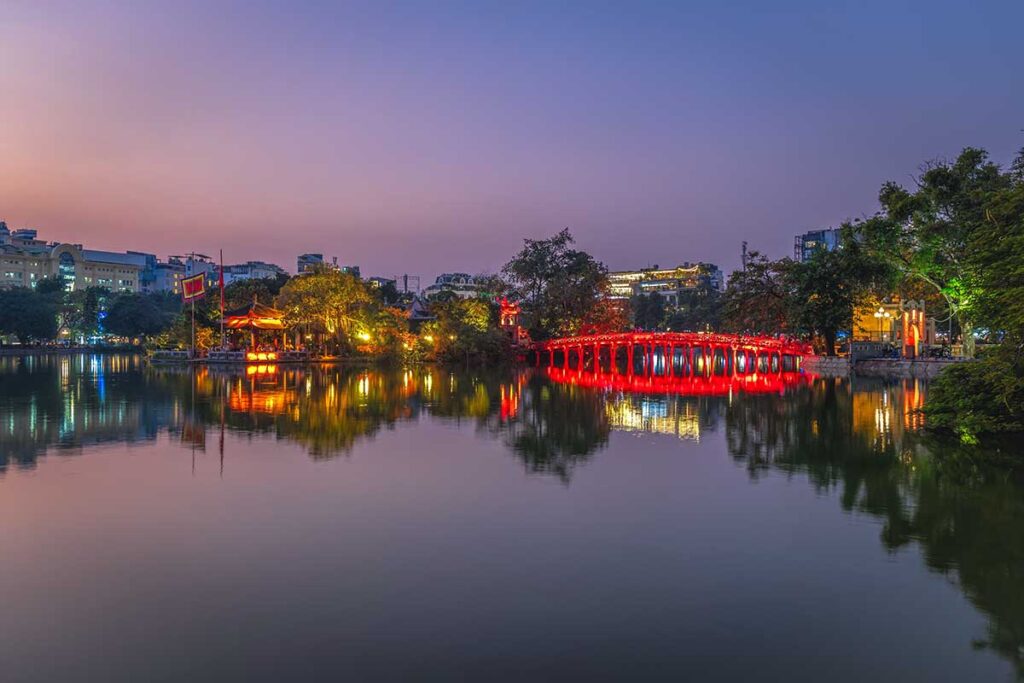
The temple buildings close in the evening, but the area remains worth visiting after dark. The Huc Bridge is beautifully illuminated in red, and the island itself glows with soft lighting. An evening stroll around Hoan Kiem Lake is one of Hanoi’s most popular pastimes, and seeing the temple from the lakeside at night often feels more atmospheric than going inside.
Nearby sights to combine with
Hoan Kiem Lake & Old Quarter Walk
Since Ngoc Son Temple sits right in Hoan Kiem Lake, it naturally fits into a broader walk around the area. A stroll around the lake offers shaded paths, benches to relax, and plenty of photo spots. From there, you can dive into the Old Quarter with its maze of narrow streets, cafés, street food stalls, and souvenir shops—a good way to experience both Hanoi’s historic and modern energy in one outing.
Thang Long Water Puppet Theater
Directly opposite the entrance to Ngoc Son Temple is the Thang Long Water Puppet Theater, one of Hanoi’s most popular cultural performances. Water puppetry is a traditional Vietnamese art form where wooden puppets are moved across a shallow pool, accompanied by live music and storytelling. Shows run several times a day, making it easy to combine a temple visit with a performance.
French Quarter walk
If you continue south from the lake, you’ll quickly enter the French Quarter, a part of Hanoi known for its wide boulevards and colonial architecture. Highlights include the Hanoi Opera House, Ly Thai To Garden with its bronze statue, and Hanoi Book Street—a short pedestrian lane lined with bookshops and cafés. This short walk gives a completely different feel from the Old Quarter and shows another side of the city’s character.
Is Ngoc Son Temple worth visiting?
Ngoc Son Temple is not the most spectacular or elaborate temple you’ll see in Vietnam, but it’s one of the most accessible and symbolic. Its central location on Hoan Kiem Lake makes it almost unavoidable during any trip to Hanoi, and walking across the red bridge to the island is an experience in itself.
The temple complex is fairly small, and you can see everything in 20–30 minutes, so it’s not worth planning as a stand-alone destination. What makes it special is the combination of history, legend, and the peaceful views over the lake, right in the busiest part of the city. Even if you decide not to go inside, the illuminated bridge and island are beautiful to see from the lakeside, especially in the evening.
In short: it’s not a “must” for its architecture alone, but it’s an easy, inexpensive, and meaningful stop that naturally fits into any Hanoi itinerary.
